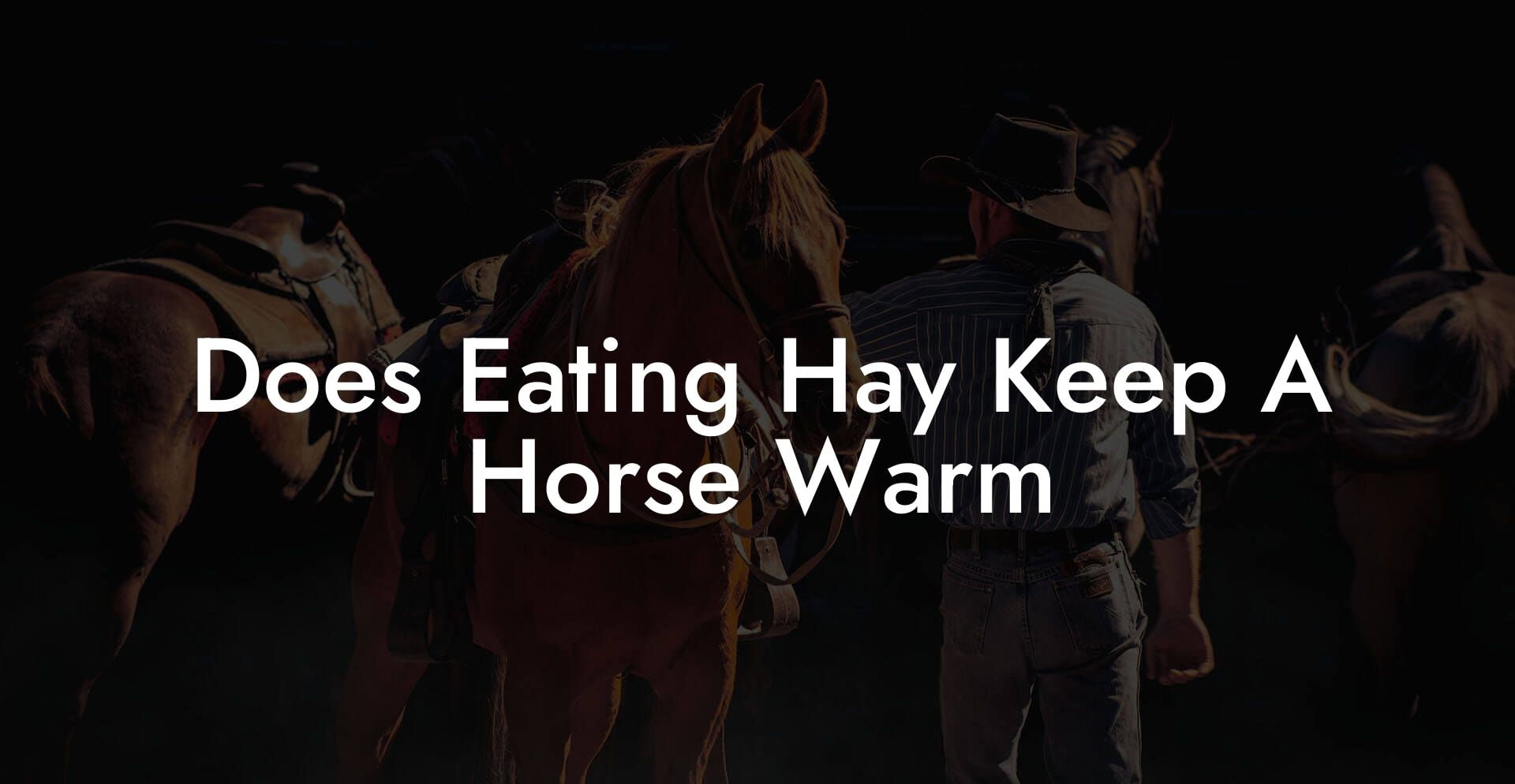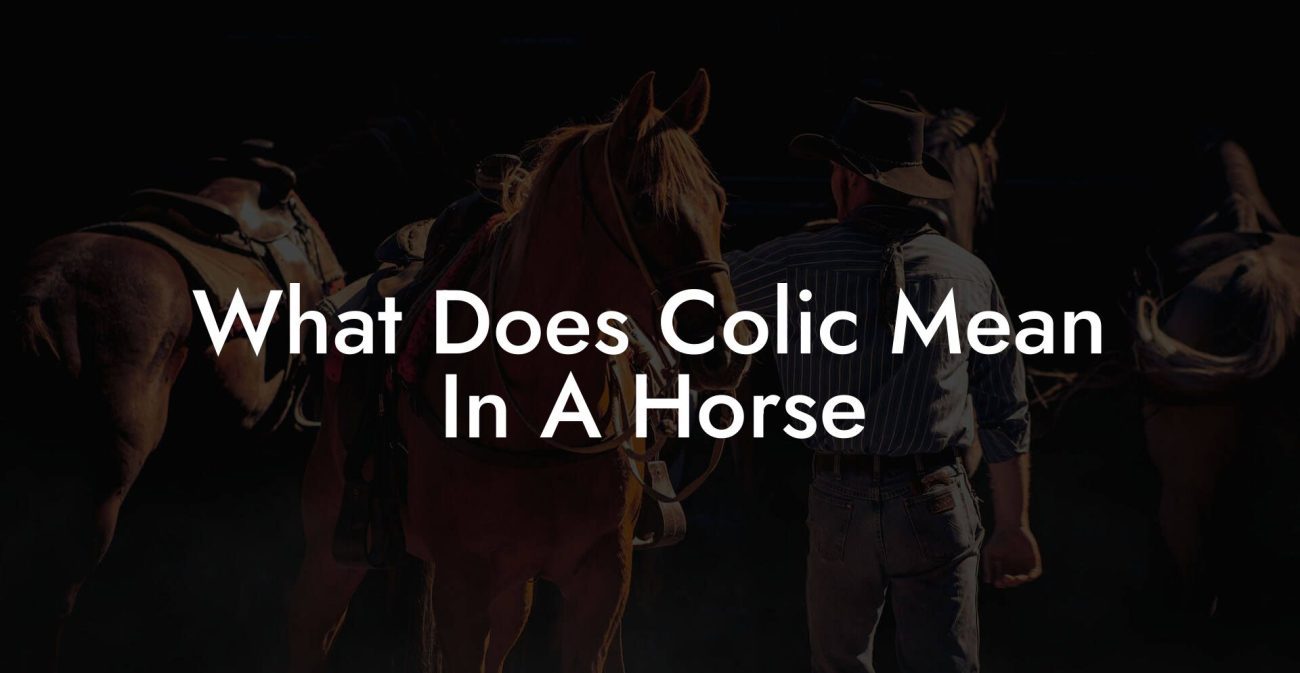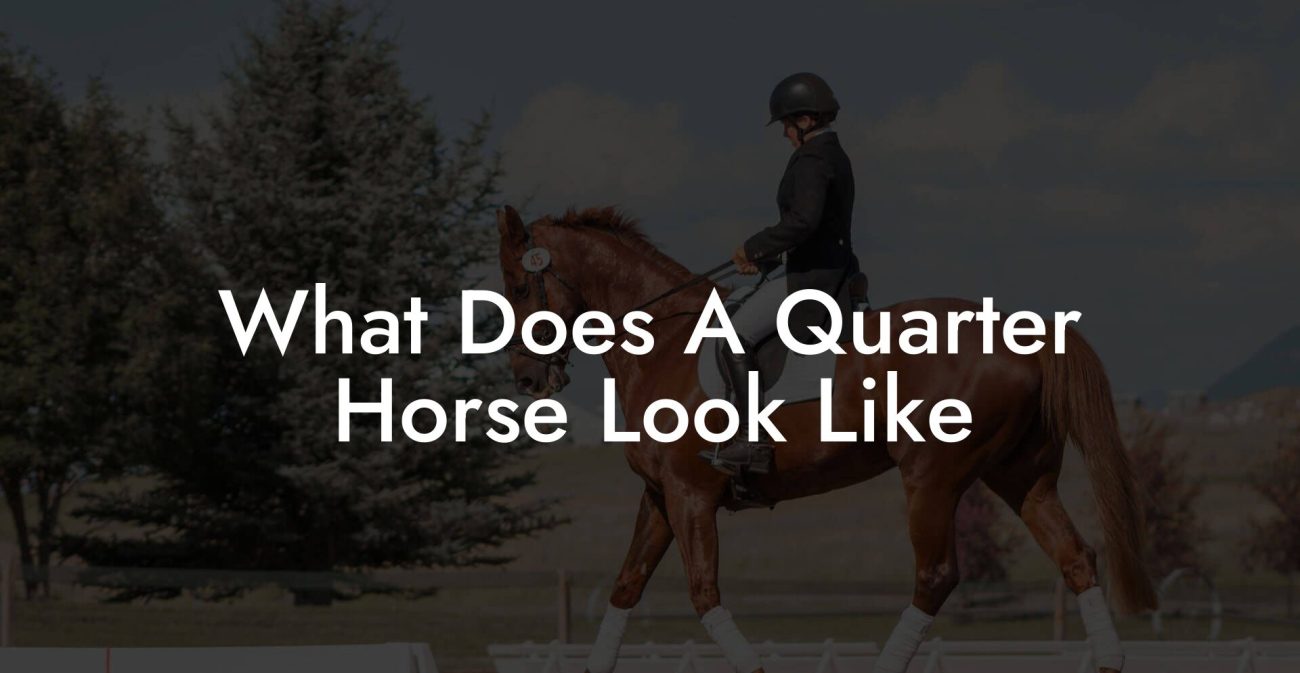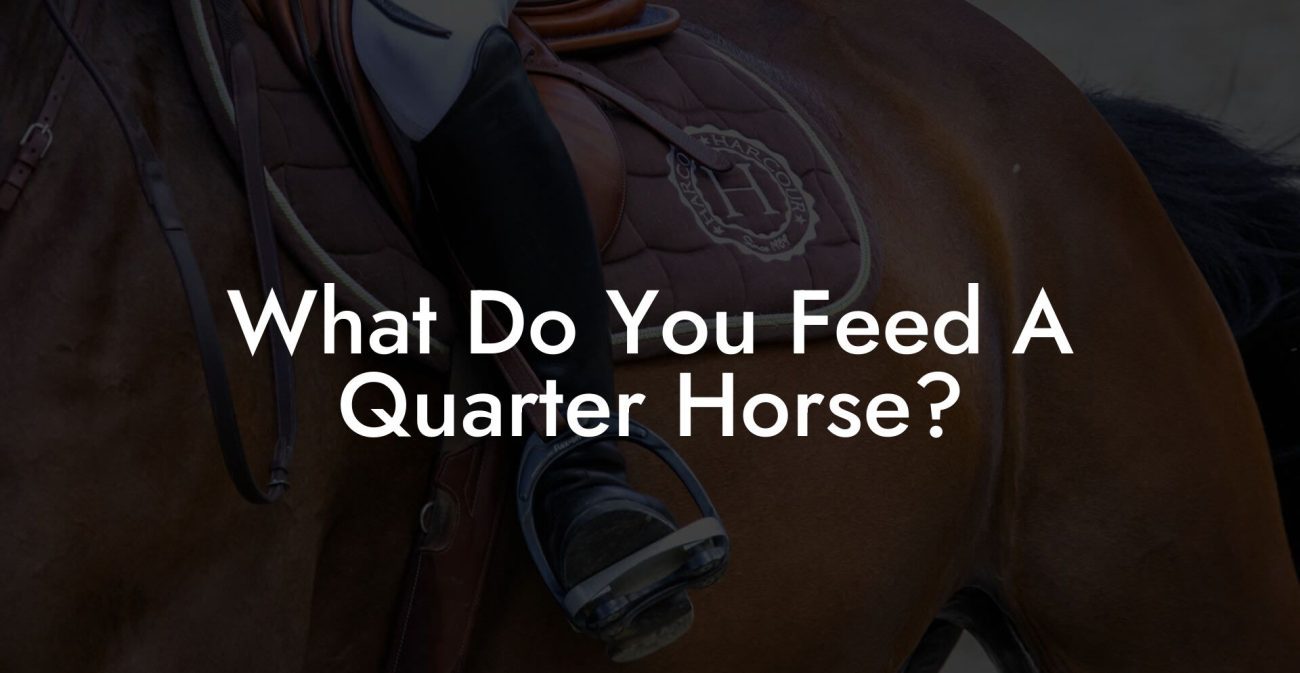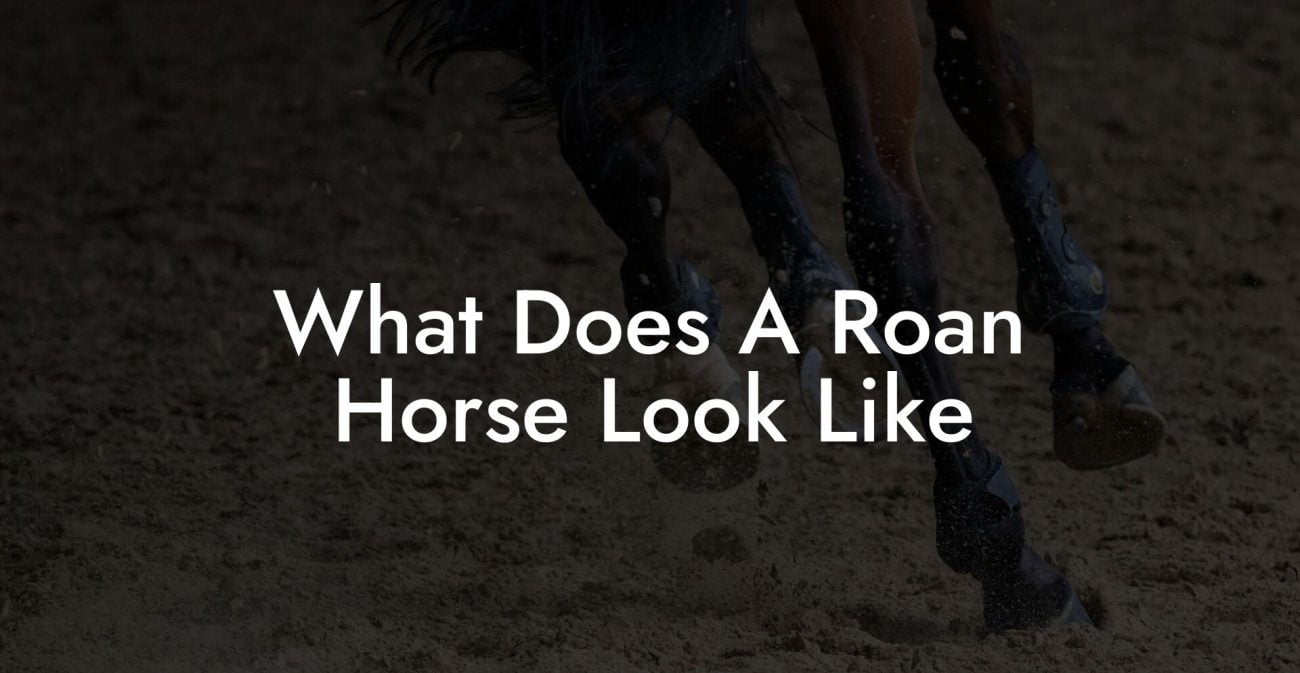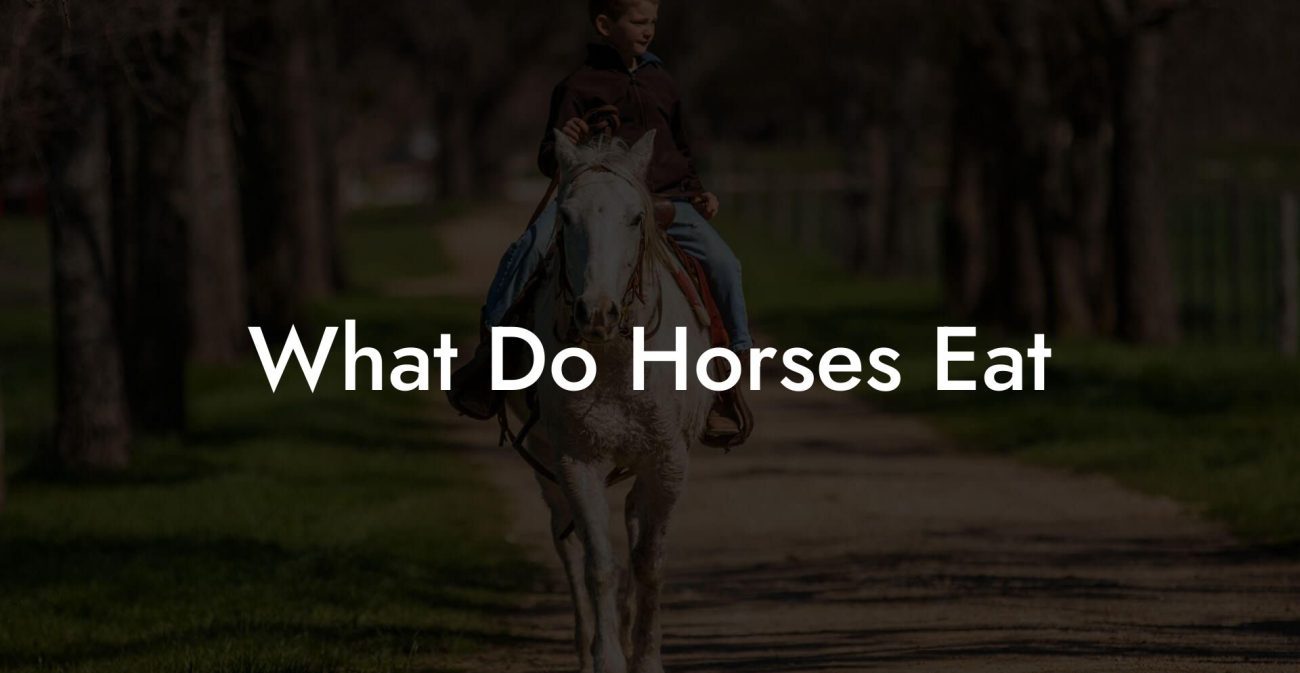Ever wondered if munching on hay could be the secret behind a horse’s cozy warmth during chilly days? Picture this: your favorite equine friend, mane flowing in the wind, snacking on that golden, nutritious hay while staying toasty even when the temperature drops. In this deep-dive guide, we unravel the fascinating connection between hay consumption and equine thermoregulation, serving up a hearty blend of science, expert insights, and real-life care tips, all with a side of humor and plenty of millennial-friendly flair.
Quick Links to Useful Sections
- The Heart of the Matter: Hay, Horses & Warmth
- The Nutritional Symphony of Hay: More Than Just Roughage
- Understanding Thermoregulation in Horses: Fueling the Internal Furnace
- Seasonal Shifts and Hay: Adapting to the Cold
- Comparing Hay to Other Feeds: What Makes It Unique?
- Quality of Hay: The Devil is in the Details
- Hay and Energy Balance: Feeding the Equine Metabolism
- Environmental Factors and Stable Management: Beyond the Feedbag
- Holistic Equine Care: Merging Nutrition with Community Wisdom
- Integrative Approaches to Equine Health: Beyond the Bowl
- Resources and Community Support: Your Next Steps to Equine Mastery
- Science, Myths, and Real-World Evidence: Debunking the Warmth Question
- Real-Life Stories: How Hay Made the Difference
- Story 1: Bella the Brisk Mare
- Story 2: Rusty the Resilient Gelding
- Story 3: Penny’s Progressive Path
- Your Journey to Equine Wellness: A Roadmap for the Modern Horse Owner
- Step 1: Assess Your Feed Quality
- Step 2: Monitor Your Horse’s Behavior
- Step 3: Combine Nutritional Best Practices with Environmental Adjustments
- Step 4: Engage with the Equine Community
- Step 5: Consult with Professionals
- Equine Wellness FAQs: Your Top Questions Answered
- Your Journey to a Warmer, Happier Horse
The Heart of the Matter: Hay, Horses & Warmth
At first glance, hay might seem like a humble feed component, just dried grasses that horses chew on day in and day out. However, hay is far more than simple fodder. It plays a pivotal role in a horse’s nutrition, health, and yes, even its ability to stay warm. While hay isn’t a magical blanket, its nutritional content contributes to the energy production and metabolism that ultimately help the horse maintain its body temperature. In other words, by fueling a horse’s internal furnace, eating hay can be an indirect but crucial factor in keeping them warm.
Think of hay as the sustainable fuel that apps up your favorite equine’s daily energy levels. When a horse grazes on high-quality hay, it receives essential nutrients that bolster its metabolism, a key player in generating body heat. For those interested in holistic horse care and understanding how different feeds affect warmth and health, delving into the science behind hay’s role in thermoregulation is like unlocking a hidden cheat code to optimal equine wellness.
The Nutritional Symphony of Hay: More Than Just Roughage
Hay is a powerhouse of nutritional goodness. Rich in fiber, vitamins, and minerals, it stands as the cornerstone of a horse’s diet. When a horse consistently consumes hay, the fiber not only supports healthy digestion but also helps maintain a steady release of energy throughout the day. This sustainable energy is what fuels the horse’s metabolic processes, contributing indirectly to maintaining core body heat.
In the realm of equine nutrition, hay is celebrated for:
- Fiber Content: Vital for a healthy digestive tract, fiber ensures that the horse’s gut remains active, which in turn supports optimal nutrient absorption.
- Caloric Supply: While not a high-calorie feed compared to grains, hay provides a consistent energy source that horses can count on during long winter months.
- Micronutrients: Vitamins A, D, and E, along with essential minerals like calcium and phosphorus, keep the horse’s muscles and bones robust, further enabling a strong metabolic rate.
- Natural Thermogenic Effect: The process of digesting fibrous materials gradually releases heat, subtly warming the horse from within during cooler days.
Moreover, the slow fermentation process that occurs in the gut of a horse when processing hay generates additional warmth, a biological bonus that complements external measures like stable insulation and blankets.
Understanding Thermoregulation in Horses: Fueling the Internal Furnace
When we talk about thermoregulation, the way in which a horse maintains its optimal body temperature, we’re really talking about a finely tuned system that balances heat production and heat loss. Horses are adept at generating body heat through metabolic activities, and the food they eat, including hay, plays a significant role in this process.
Here’s how hay factors into the equation:
- Steady Energy Release: The digestion of hay requires energy and leads to the gradual release of heat, a phenomenon known as diet-induced thermogenesis. This is particularly beneficial during cold weather when the body needs to stay warm.
- Enhanced Metabolism: The nutrients in hay boost the metabolic rate, ensuring that energy is consistently produced and used to maintain the horse’s core temperature.
- Efficient Nutrient Utilization: By supplying a balanced mix of fiber and micronutrients, hay helps horses avoid the metabolic spikes and drops associated with concentrated feeds. This balance is crucial for steady heat production.
Essentially, the interplay between a horse’s diet and its metabolic heat production shows that hay is not merely a filler feed, it's instrumental in fueling the internal furnace that keeps horses comfortable, even in frosty conditions.
Seasonal Shifts and Hay: Adapting to the Cold
As the seasons change, so too do the needs of your four-legged companion. Winter brings a unique set of challenges, forcing horses’ bodies to work harder to maintain a stable internal temperature. During these colder months, hay becomes an invaluable component of equine care.
Here’s why hay is especially critical in winter:
- Sustained Energy Provision: When temperatures drop, a horse's body ramps up its energy expenditure to generate heat. High-quality hay offers a continuous energy source that supports this heightened metabolic need.
- Digestive Warmth: The fermentation of fiber in the gut produces warmth, a natural byproduct that helps keep the animal’s core temperature above the freezing point.
- Digestive Health & Immunity: A well-functioning digestive system bolsters overall immunity. In the cold, staying healthy means fewer trips to the sick bay and more time enjoying the winter scenery.
- Behavioral Consistency: Horses that receive ample hay tend to exhibit more stable behaviors in colder environments, as consistent digestion alleviates stress and discomfort.
For modern horse owners, especially those plugged into holistic and integrative care routines, understanding how seasonal changes affect equine nutrition is key. It supports decisions not only about feed type but also about stable management, exercise schedules, and overall health monitoring.
Comparing Hay to Other Feeds: What Makes It Unique?
While hay is a longtime staple in equine diets, it’s important to understand how it stacks up against other feed options, such as grains and concentrates. The focus here is on balance, both in terms of energy and temperature regulation.
Grains and concentrates are known for their high caloric density. They’re ideal for horses with high energy demands or those engaged in intensive activities such as racing or eventing. However, they come with a caveat: a rapid release of energy that can lead to metabolic peaks followed by troughs. These fluctuations can sometimes disrupt steady thermoregulation.
In contrast, hay offers a slow, steady release of nutrients, ensuring that horses have a consistent energy flow. This is particularly beneficial for:
- Maintaining Stable Energy Levels: The gradual energy release helps in keeping the metabolic furnace burning steadily without the rollercoaster effect of high-glycemic diets.
- Supporting Gut Health: The high fiber content in hay promotes a healthy digestive tract, which is essential for overall wellness and temperature regulation.
- Reducing Stress on the Liver: Concentrated feeds can overburden the liver, while hay, as a natural feed, supports balanced digestion and metabolism.
The takeaway? While grains have their place in the equine dietary portfolio, hay remains a cornerstone for maintaining overall health and warmth. It’s nature’s own slow-cooker, releasing benefits gradually and reliably.
Quality of Hay: The Devil is in the Details
Not all hay is created equal, and when it comes to helping your horse stay warm, the quality of hay matters immensely. The nutritional density of hay can vary based on several factors, including the type of grass, the stage of harvest, storage conditions, and regional climate variations.
Let’s break down the key indicators of high-quality hay:
- Leaf-to-Stem Ratio: A higher leaf content means more nutrients and digestible fiber, which is crucial for energy production and metabolic heat generation.
- Moisture Content: Properly cured hay with the right moisture content minimizes the risk of mold and ensures that the nutritional profile remains intact. Excessively dry hay might lose some of its nutritional punch, while overly moist hay can spoil quickly.
- Color and Aroma: Fresh, vibrant hay has a greenish-brown hue and a pleasant, earthy smell. Dull or yellowed hay can signal nutrient depletion or poor storage practices.
- Particle Size: Finely cut hay can sometimes pack more nutritional density per bite, making it easier for horses to digest and extract energy efficiently.
Investing in premium hay not only benefits your horse’s overall health but also plays a subtle role in ensuring that their internal energy production, and by extension, their warmth, is optimized. Quality hay translates to quality care.
Hay and Energy Balance: Feeding the Equine Metabolism
A balanced diet is the keystone of any successful equine care program. When we talk about energy balance, it’s all about providing just the right amount of calories to support the horse’s daily activities without tipping the scale toward weight gain or energy depletion.
Hay supplies a moderate level of calories compared to concentrates, which plays an essential role in maintaining homeostasis. Here’s how:
- Steady Caloric Intake: The uniform digestion pattern of hay ensures that horses have a continuous and moderate supply of energy. This consistency helps stabilize the internal temperature by avoiding the sudden metabolic spikes often associated with high-energy feeds.
- Role in Body Fat Regulation: The gradual breakdown of hay supports a healthy metabolism that balances energy storage and expenditure. For horses, maintaining an optimal body fat percentage is not only a matter of physique, it’s directly linked to their ability to insulate and sustain warmth.
- Enhanced Digestive Efficiency: Slow, methodical digestion encourages the production of heat as a natural byproduct. In effect, every bite of hay contributes not only to nutrition but also to that subtle, internal warming process.
In colder months, when every calorie counts and maintaining body heat is paramount, hay shines as a dependable source of both fuel and warmth. This balance is at the heart of sustainable horse care, a holistic approach that intertwines nutrition and thermoregulation.
Environmental Factors and Stable Management: Beyond the Feedbag
While the nutritional properties of hay play a significant role in keeping your horse warm, they’re just one piece of the puzzle. Environmental factors and proper stable management are critical for creating an overall cozy habitat for your equine companion.
Consider these key aspects of winter management:
- Stable Insulation: A well-insulated stable minimizes drafts and retains heat, creating a microclimate where your horse’s internal warmth can be efficiently conserved. Even the best hay can only do so much if your horse is exposed to relentless gusts of cold air.
- Wind Barriers: Positioning fences or planting windbreaks around pastures and stables can significantly dampen the wind chill effect, reducing the burden on your horse’s metabolism.
- Proper Ventilation: It might sound counterintuitive, but well-ventilated stables prevent the build-up of dampness, a factor that can intensify the cold and invite respiratory issues.
- Hydration Strategies: In winter, horses may drink less water, which can affect digestion. Keeping water sources from freezing and ensuring regular hydration are essential parts of holistic horse care.
Hence, while hay contributes its own warmth through metabolic processes, the overall strategy for keeping horses warm is a multi-faceted approach that integrates diet, stable management, and environmental awareness. Modern equine enthusiasts know that warmth isn’t just about turning up the thermostat, it’s about creating a balanced, comfortable environment where nutrition and care converge.
Holistic Equine Care: Merging Nutrition with Community Wisdom
For Gen-Z and millennial horse owners, caring for your equine companion goes beyond mere feeding schedules. It’s about embracing a lifestyle that fuses cutting-edge scientific insights with traditional knowledge and community support. In today’s digital age, you have access to a vast network of experts, online forums, interactive apps, and social media groups dedicated to holistic horse care.
By integrating nutritional strategies (like optimizing hay quality and feeding schedules) with state-of-the-art stable management techniques, you’re not only fostering a healthy horse, you’re also becoming part of a larger movement that values sustainability, well-being, and mutual support. Whether you’re sharing tips on Instagram or engaging with experts on equine care blogs, the modern approach is collaborative and full of heart.
In this ecosystem, every piece of hay becomes a small victory, contributing to a cascade of benefits that enhance your horse’s health, performance, and comfort. Welcoming innovative ideas such as digital feeding trackers, environmental sensors, and even community-led hay sharing programs can transform routine care into a dynamic, engaging, and effective regimen.
Integrative Approaches to Equine Health: Beyond the Bowl
The conversation around equine health is evolving, and modern care practices now embrace integrative approaches that harmonize nutrition, exercise, behavioral enrichment, and even mindfulness. While hay is a fundamental element of this equation, it’s also about how you use every resource at your disposal to create a thriving, balanced life for your horse.
Consider these integrative strategies that complement a hay-based diet:
- Regular Exercise and Movement: Beyond grazing, incorporate structured exercise and free movement to help your horse maintain muscle tone and overall metabolic rate. A well-exercised horse will more effectively utilize all the nutrients provided by hay, turning them into sustained internal energy and warmth.
- Behavioral Enrichment: A happy horse is a resilient horse. Activities like puzzle feeders, social interactions with herd mates, and rotating pastures keep them mentally engaged, which in turn positively affects their physical health and metabolism.
- Supplemental Therapies: Some owners explore complementary therapies such as massage, acupuncture, or even hydrotherapy to support circulation and muscle relaxation. These practices can work synergistically with a nutrition-focused regimen to keep your horse in tip-top shape.
- Seasonal Feeding Adjustments: As the weather changes, so should the feeding strategy. Timely adjustments in hay quality and quantity, combined with occasional supplemental feeds, ensure that the equine energy balance is maintained even when the thermostat drops.
By adopting a holistic approach, you transform routine horse care into an art form, one that harmonizes the simplicity of hay with sophisticated methods of wellness, style, and community wisdom.
Resources and Community Support: Your Next Steps to Equine Mastery
Ready to take your horse care routine to the next level? Whether you’re a seasoned equestrian or just starting out on your journey, tapping into a network of trusted resources and community support can make all the difference. Here are some avenues to consider:
- Online Forums and Social Media Groups: Join communities on platforms like Facebook, Reddit, and Instagram where fellow horse enthusiasts share tips, success stories, and advice on everything from hay quality to winter stable hacks.
- Professional Webinars and Workshops: Many equine nutritionists and veterinarians host online sessions that dive deep into the latest research on equine diet and health, offering insights on how to maximize the benefits of hay.
- Local Equine Clubs and Associations: Connecting with local clubs not only boosts your practical knowledge but also opens doors to community events, farm tours, and collaborative learning experiences with experts on equine care.
- Mobile Apps and Digital Trackers: Leverage technology to track feeding schedules, monitor environmental conditions, and get reminders for nutritional adjustments, all designed to keep your horse comfortable and well-fed.
- Veterinary Consultations: Never underestimate the value of professional guidance. Regular check-ups with an equine veterinarian or nutritionist can provide personalized advice tailored to your horse’s unique needs.
Each of these resources offers a pathway not just to improved equine nutrition, but to a more integrated, informed, and community-driven approach to horse care. Embrace these tools and join a growing movement where knowledge meets passion.
Science, Myths, and Real-World Evidence: Debunking the Warmth Question
So, the burning question remains: Does eating hay keep a horse warm? The short answer is that hay, through its steady provision of energy and support for healthy metabolism, plays a key role in helping horses maintain their body heat. But, as with any topic where science meets folklore, there are plenty of myths and misconceptions that need debunking.
One common myth suggests that hay acts like a physical insulator, almost like a natural sweater for your horse. While hay doesn’t literally trap heat around the body like a wool blanket might, the process of digesting fiber does generate heat as a natural side effect. In scientific terms, this is known as diet-induced thermogenesis, and it is a well-documented phenomenon in many species, including horses.
Real-world evidence gathered from equine nutrition studies highlights the importance of a high-fiber diet during cold weather. Horses that receive ample, quality hay display improved metabolic stability, fewer signs of cold stress, and exhibit overall better performance during winter months. Of course, this doesn’t mean that hay alone is a panacea, proper shelter, hydration, and additional nutritional support when needed are all part of the equation.
Ultimately, integrating hay into your horse’s diet is a scientifically sound practice that contributes to overall warmth and well-being. The key lies in understanding how this humble feed interacts with dietary, environmental, and biological factors to create a harmonious balance that benefits the horse both physically and energetically.
Real-Life Stories: How Hay Made the Difference
There’s nothing quite like hearing from fellow horse owners who have witnessed the transformative power of a hay-rich diet. Across stables and pastures, countless anecdotes highlight how strategic feeding routines have helped horses thrive in the cold.
Story 1: Bella the Brisk Mare
Bella, a spirited mare with a love for winter trots, had previously struggled during the harshest months. Despite a well-cared-for stable and spirited exercise routines, she was often seen shivering and lethargic. Her owner decided to revamp her diet, increasing the proportion of quality hay while reducing concentrated feeds. Over the winter, Bella not only maintained a steady body temperature but also exhibited renewed energy and a noticeable glow of health. Her transformation underscored the subtle yet potent influence of a well-calibrated hay regimen.
Story 2: Rusty the Resilient Gelding
Rusty’s stablemate in a busy boarding facility, this 12-year-old gelding had a reputation for being tough, but even he wasn’t immune to the rigors of cold weather. Observing that Rusty’s coat wasn’t as lustrous during the winter, his caretaker began experimenting with a dietary shift that emphasized premium hay of higher fiber content. Within a few weeks, Rusty’s coat improved, and he spent more time contentedly chewing on his hay rather than pacing restlessly in search of warmth. His story became a testament to how small nutritional tweaks can lead to significant improvements in equine comfort.
Story 3: Penny’s Progressive Path
Penny, a young, energetic filly in a small family barn, was renowned for her playful demeanor, but during one particularly frigid winter, she began displaying signs of discomfort. A consultation with an equine nutritionist revealed that while her overall diet was balanced, the quality and quantity of hay needed adjustment. With a targeted hay feeding plan enriched with a mix of alfalfa and timothy, Penny’s newfound energy and warmth were evident. Her owner not only learned the importance of seasonal dietary adjustments but also gained valuable insights into the nuanced role of hay in overall equine well-being.
These real-life experiences illustrate that while hay might not be a direct heater, it sets the stage for an internally maintained warmth that supports a horse’s overall resilience during cold weather. Stories like these inspire modern horse enthusiasts to reimagine feed management as a multifaceted tool for holistic health.
Your Journey to Equine Wellness: A Roadmap for the Modern Horse Owner
Integrating hay into your horse’s daily routine is only one element of a broader journey toward holistic equine wellness. For those of you who are ready to transcend the basics and step into the future of horse care, here’s a roadmap to guide your efforts:
Step 1: Assess Your Feed Quality
Begin by evaluating the quality of the hay you’re currently using. Look for vibrant color, a high leaf-to-stem ratio, and minimal dust. Consult with local feed experts if needed to choose the best options tailored to your climate and the specific needs of your horse.
Step 2: Monitor Your Horse’s Behavior
Keep a close eye on your horse’s energy levels, coat condition, and overall demeanor. Notice if there are changes in how your horse responds to the winter chill, and adjust the diet accordingly. A well-fed horse will exhibit a healthy appetite and a steady temperament.
Step 3: Combine Nutritional Best Practices with Environmental Adjustments
Don’t rely solely on diet, pair quality hay with optimal stable management. Ensure your barn is properly insulated, implement windbreaks, and prioritize hydration. These small steps work holistically to boost dryness and warmth.
Step 4: Engage with the Equine Community
Leverage resources from online horsemanship forums, social media groups, and local clubs. Sharing insights and experiences not only broadens your knowledge, but also enriches your ability to customize a feeding and care strategy that suits your horse perfectly.
Step 5: Consult with Professionals
Regular check-ins with equine nutritionists and veterinarians ensure that your horse’s diet remains aligned with its evolving needs. Don’t hesitate to seek professional advice when making significant changes.
This roadmap is designed to empower you, enabling a proactive approach to feeding, welfare, and overall equine health that resonates with modern, informed horse owners. Every step you take is a stride toward a warmer, healthier, and more vibrant life for your sanctuary companion.
Equine Wellness FAQs: Your Top Questions Answered
Below are some frequently asked questions that explore the intricate relationship between hay consumption and a horse’s ability to stay warm, as well as broader topics on equine care:
1. Does eating hay really contribute to a horse staying warm?
Yes, indirectly. While hay doesn't serve as a direct insulator, its high fiber content and the resulting fermentation in the gut generate heat, supporting the horse's overall thermoregulation.
2. How does hay differ from grains in supporting metabolic heat?
Hay provides a slow, steady release of energy and supports healthy digestion, whereas grains offer a quick, high-calorie boost that can lead to rapid metabolic spikes and drops.
3. What should I look for when selecting hay for the winter?
Choose hay that is fresh, has a high leaf-to-stem ratio, and is properly cured to retain nutrients and prevent spoilage. Quality hay helps maintain a stable energy supply during cold weather.
4. Can overfeeding hay cause negative side effects for a horse?
Yes, as with any feed, overfeeding hay can lead to issues such as weight gain or digestive upset. It’s important to balance hay intake with overall nutritional needs and exercise levels.
5. Are there different types of hay that are better for warmth?
Different grasses and legumes offer varying nutritional profiles. For instance, alfalfa is richer in calories and protein compared to timothy hay, making it a good option for horses with higher energy needs in cold conditions.
6. How do environmental factors influence the effectiveness of hay?
A well-insulated stable, effective windbreaks, and proper hydration all work in conjunction with hay’s nutritional benefits to maintain a horse’s body heat.
7. What role does fiber play in the digestion process related to heat production?
Fiber, when fermented in the horse’s gut, produces heat as a byproduct. This slow release of heat helps support a steady metabolic rate, which is critical for thermoregulation.
8. How can I adjust my horse’s diet as the weather changes?
Monitor your horse’s behavior and energy levels, adjust the hay quality and quantity seasonally, and consider supplementing with additional nutritionally dense feeds if needed.
9. Are there practical tips for integrating hay with other holistic care methods?
Yes, combine quality hay with proper exercise, regular veterinary care, and environmental enhancements for a well-rounded approach to equine wellness.
10. Where can I find more information about holistic equine care?
Explore reputable equine care blogs, join local and online equestrian communities, and consult with equine nutrition and veterinary professionals to stay informed on the latest practices.
Your Journey to a Warmer, Happier Horse
Embracing the power of hay isn’t just about feeding, it's about investing in your horse's long-term comfort, health, and happiness. Every bite of quality hay fuels your horse’s internal furnace, supports steady metabolism, and contributes to a lifestyle where nutrition and care go hand in hoof.
Remember, modern equine care is a multi-dimensional endeavor. It melds nutritional science, environmental management, and the community wisdom of passionate horse owners whose shared goal is to ensure that every horse can thrive even in the chill of winter. By prioritizing a balanced hay feeding regimen and pairing it with smart stable management and integrative care, you're setting the stage for a resilient, joyful horse that not only survives but thrives.
So step into this new era of equine care with confidence. Let each bite of hay be a building block in a pyramid of wellness, sustaining your horse’s warmth from the inside out.
Your journey toward a warmer, healthier, and happier horse starts today. Embrace the facts, trust in the science, and let your holistic care routine shine as a beacon of modern, mindful horse ownership.

